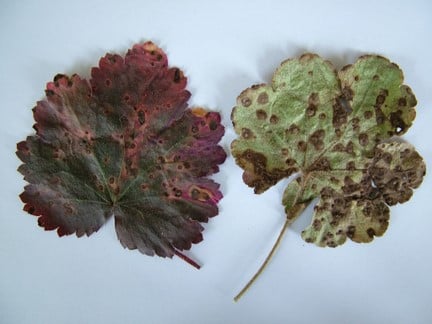
Quick facts
Common name - Heuchera rust
Scientific name - Puccinia heucherae
Plants affected - Heuchera. In the USA other members of the Saxifragaceae can also be attacked
Main symptoms - Spots, depressions or bumps on the upper leaf surface. Raised orange-brown or greyish-white pustules on the corresponding underside
Caused by - Fungus
Timing - Summer
What is heuchera rust?
Heuchera rust is a disease of Heuchera foliage caused by the fungus Puccinia heucherae. The disease, which is common in the USA, was recorded in the UK for the first time in 2004, on a sample received by the Pathology department at Wisley from an RHS member. It has since become widespread. The disease is spread by airborne spores, and attacks are worst during wet summers.
Symptoms
You may see the following symptoms:
- Small brown spots, sunken depressions or raised bumps on the upper leaf surface
- Raised, orange to brown spore-producing pustules on the corresponding underside
- The pustules may turn a greyish-white colour under humid conditions
- Pustules may also sometimes be produced on the upper surface
- Young leaves may become puckered and distorted
- Heavily-infected older leaves may turn brown and shrivel
- Old infection spots may fall out giving a shot-hole appearence
- Leaf stalks (petioles) may also be affected
Control
The RHS believes that avoiding pests, diseases and weeds by good practice in cultivation methods, selection, and encouraging or introducing natural enemies, should be the first line of control. If chemical controls are used, they should be used only in a minimal and highly targeted manner.
Non-chemical control
- When purchasing Heuchera plants inspect the foliage closely, and reject any plants showing symptoms of rust infection
- Consider quarantining bought-in plants, if in leaf, for three to four weeks, particularly if you have unaffected Heuchera plants in your garden. Keep the new plants well away from the others, and inspect them every week for symptoms
- Remove the old, senescing leaves from plants in autumn to help to prevent the fungus from overwintering
- Avoiding growing heucheras in areas with poor air circulation, as high and leaf wetness are favourable for infection
- If the plants are to be watered, do so in the morning so that the leaf surfaces dry out rapidly
- Remove and dispose of any affected foliage – do not it
Fungicides
The RHS recommends that you don't use fungicides. Fungicides (including organic types) may reduce , impact soil health and have wider adverse environmental effects. If you do intend to use a fungicide, please read the information given in the link and download below to ensure that use, storage and disposal of the product is done in a responsible and legally compliant manner.
The products listed in the ‘Fungicides for gardeners’ document below are legally available for use by home gardeners in the UK. This information is provided to avoid misuse of legal products and the use of unauthorised and untested products, which potentially has more serious consequences for the environment and wildlife than when products are used legally. Homemade products are not recommended as they are unregulated and usually untested.
Download
Fungicides for gardeners (Adobe Acrobat pdf document outlining fungicides available to gardeners)
Link
Biology
The rust fungi are described as biotrophs; that is, they grow within the living tissues of the plant and extract from the cells. Although they do not kill tissues rapidly, heavy attacks by rusts can cause tissues to collapse and die prematurely and this is the case with heuchera rust.
The orange to brown pustules contain numerous spores called teliospores that remain embedded within the leaf. Under humid conditions the teliospores germinate to produce a second spore type called a basidiospore. It is the production of the minute basidiospores that causes the pustules to turn a greyish-white colour, and it is these spores that are carried in air currents to create new infections when they land on other heuchera leaves.
Infection is favoured by wet or humid conditions. The disease is therefore most problematic during wet summers. The fungus overwinters on any affected leaves remaining on the plants. New leaves emerging in spring soon produce rust pustules.
Like many rust diseases, heuchera rust has a ‘latent period’, when infection of the plant has occurred but symptoms are not yet visible. Depending on environmental conditions this latent period could range from a few days to several weeks. It is therefore possible that bought-in plants could be harbouring the disease.
Susceptibility
In the UK the disease has so far been confined to Heuchera, but in the USA other members of the Saxifragaceae can be affected, including Lithophragma, Mitella, Saxifraga, Tellima, Tiarella and Tolmiea. There is considerable variation in susceptibility between different cultivars of Heuchera.
Unlike some other rust diseases no alternate host is involved in its lifecycle.




